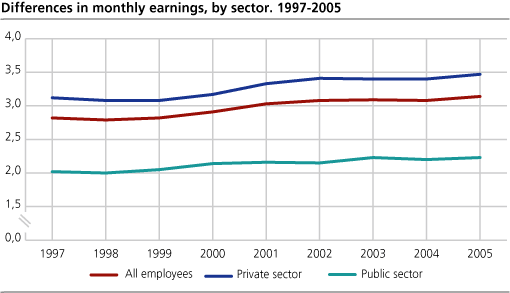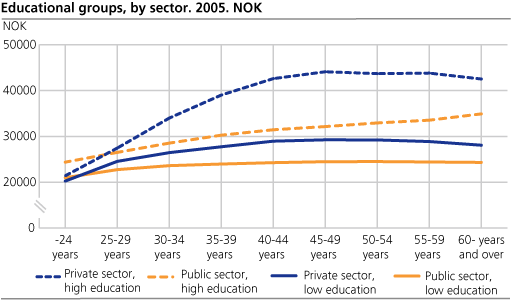Content
Published:
This is an archived release.
Monthly earnings up 3.3 per cent
Average monthly earnings for an employee were NOK 29 200 per third quarter 2005. This was an increase of just above NOK 900 or 3.3 per cent from 2004.
Monthly earnings for employees working full-time amounted to NOK 30 100 per third quarter 2005, an increase of NOK 1 000 or 3.5 per cent. In comparison employees working part-time had monthly earnings of NOK 24 800, which was an increase of NOK 700 or 2.8 per cent. To compare earnings of full-time and part-time employees, the earnings of part-time employees are recalculated as if they were working full-time. This is called full-time equivalents.
|
Average monthly earnings, by sex and working
hours per 3rd quarter 20041 and 2005. Full-time equivalents. NOK |
| Sex and working hours | Monthly earnings, total | Percentage change | |||||||||||||||||||||||||||||||||||||
|---|---|---|---|---|---|---|---|---|---|---|---|---|---|---|---|---|---|---|---|---|---|---|---|---|---|---|---|---|---|---|---|---|---|---|---|---|---|---|---|
| 20041 | 2005 | 2004-2005 | |||||||||||||||||||||||||||||||||||||
| Total | 28 200 | 29 200 | 3.3 | ||||||||||||||||||||||||||||||||||||
| Males | 30 200 | 31 200 | 3.3 | ||||||||||||||||||||||||||||||||||||
| Females | 25 600 | 26 400 | 3.4 | ||||||||||||||||||||||||||||||||||||
| Full-time | 29 100 | 30 100 | 3.5 | ||||||||||||||||||||||||||||||||||||
| Males | 30 500 | 31 600 | 3.5 | ||||||||||||||||||||||||||||||||||||
| Females | 26 400 | 27 400 | 3.6 | ||||||||||||||||||||||||||||||||||||
| Part-time | 24 100 | 24 800 | 2.8 | ||||||||||||||||||||||||||||||||||||
| Males | 25 100 | 25 600 | 1.8 | ||||||||||||||||||||||||||||||||||||
| Females | 23 800 | 24 600 | 3.0 | ||||||||||||||||||||||||||||||||||||
| 1 | The figures are corrected. |
Small differences in wage development for males and females
Females had monthly earnings of NOK 26 400, while monthly earnings for males were NOK 31 200. This corresponds to an increase of 3.4 and 3.3 per cent, respectively. Monthly earnings of females were 84.7 per cent of men’s in 2005, which was about the same as in 2004.
Females in private sector had monthly earnings which was 83.8 per cent of men’s, while the corresponding number in public sector was 87.4 per cent.
Occupational groups in private sector
Technicians and associate professionals in private sector had monthly earnings of NOK 33 100 in 2005, an increase of NOK 1 400 or 4.3 per cent from the previous year. One quarter of this growth was due to growth in bonuses, while just above 70 per cent were due to growth in basic paid salary. Bonuses varied significantly across divisions with the largest amounts in financing and oil and gas extraction. Professionals had monthly earnings of NOK 40 100, which corresponds to an increase of NOK 1 300 or 3.3 per cent.
Monthly earnings for market sales workers and service workers were NOK 22 400, an increase of NOK 700 or 3.2 per cent. In comparison craft workers and operators had monthly earnings of NOK 26 300 and 25 100, respectively. This corresponds to an increase of 3.2 per cent for both occupational groups.
Senior officials and managers had monthly earnings of NOK 44 900, an increase of NOK 1 300 or 2.9 per cent.
Larger wage-differences in private sector
Monthly earnings for public sector employees were NOK 27 900 in 2005, while private sector employees had monthly earnings of NOK 29 700.
Figure 1 shows the relation between the ten per cent of all employees with highest and lowest monthly earnings. The wage differences have been increasing for the entire period in both sectors, and in 2005 the top ten per cent had more than three times the monthly earnings of the lowest ten percent.
The wage differences are largest in the private sector where the ratio increased from 3.1 in 1997, to 3.5 in 2005. In the public sector the differences are smaller, and the ratio has increased from 2.0 to 2.2 in the same period.
Education pays better in the private sector
Figure 2 shows that monthly earnings were higher in private than in public sector for employees with high as well as low education. Wages generally grow with age, and even out or decrease from the age of 45-49 years. There is an exception for highly educated public employees where the oldest employees have the highest monthly earnings.
The highly educated group is comprised of employees with tertial education. In the private sector the highest monthly earnings were found in the age group between 45 and 49 years with NOK 44 100. For public sector employees the best paid age group was those of 60 years or more with monthly earnings of NOK 34 900.
The low educated group consists of employees with secondary education or less. Among these the public sector employees showed only small differences between the age groups. Those privately employed increased in the same pattern as the highly educated in their sector, although at a slower pace.
About the statistical basis
The statistics are based on information from a sample of enterprises with a total of 1 341 524 employees per 3rd quarter 2005. It covers all sections except for agriculture, hunting and forestry. The data for this statistics have not been collected separately, but is an assembly of previously published statistics for the individual sections. According to preliminary figures from the National Accounts for the 3rd quarter 2005, the statistics cover about 2 040 600 employees.
Figures for 2004 are corrected.
Tables:
- Table 1 Average monthly earnings, by sector, working hours and sex per 3rd quarter 2005. Full-time equivalents. NOK
- Table 2 Average monthly earnings, by sector, working hours and sex per 3rd quarter 2004. Full-time equivalents. NOK
- Table 3 Average monthly earnings for employees, by working hours and section per 3rd quarter 2005. Full-time equivalents. NOK (Corrected 23 June 2006 at 1100)
- Table 4 Average monthly earnings for employees, by working hours and section per 3rd quarter 2004. Full-time equivalents. NOK
- Table 5 All employees in private sector. Average monthly earnings, by sex and occupational group per 3rd quarter 2005. Full-time equivalents. NOK
- Table 6 All employees in private sector. Average monthly earnings, by sex and occupational group per 3rd quarter 2004. Full-time equivalents. NOK
Additional information
Contact
-
Arbeidsmarked og lønn
E-mail: arbeidsmarked@ssb.no
-
Knut Snellingen Bye
E-mail: knut.snellingen.bye@ssb.no
tel.: (+47) 40 81 13 26
-
Magnus Berglund Johnsen
E-mail: magnus.johnsen@ssb.no
tel.: (+47) 40 90 23 75
-
Fredrik Steinrem Edelmann
E-mail: fredrik.edelmann@ssb.no
tel.: (+47) 40 90 24 60
-
Knut Håkon Grini
E-mail: knut.grini@ssb.no
tel.: (+47) 48 20 51 63


